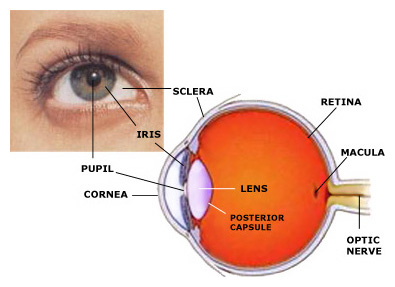16 Essential Parts of the Human Eye everyone needs to know about.
Your eyes are the windows to your soul. They allow you to see the world and enjoy every day life. Do you know what parts comprise this amazing organ? The more you understand your eyes, the more you can appreciate them. Here are 16 Essential Parts of Your Eyes by Allabouteyes.com/understanding-different-parts-eye/
- Anterior Chamber
The anterior chamber rests behind your cornea but in front of your lens and iris. It holds the aqueous humor and allows it to drain properly from your eyes into your bloodstream.
- Aqueous Humor
This thick fluid rests in the anterior chamber and provides nutrients to these two parts of your eyes. The liquid must drain regularly, and your body replaces it. However, if you develop glaucoma, this fluid will build up, creating an uncomfortable pressure in your eyes.
- Choroid
This small, vascular layer sits between your eye’s sclera and retina. It provides the outer layers of the retina with nourishment (through blood vessels) and oxygen. While you won’t develop health issues in the choroid, this component refracts light, causing the red-eye effect in photos.
- Ciliary Body
The ciliary body sits between your choroid and iris, and it produces the aqueous humor and holds the lens in place.
- Conjunctiva
This clear membrane covers the white portion of your eye, or the sclera. The conjunctiva also covers the inside of your eyelids. It produces mucus and tears to lubricate your eyes and keeps microbes out of your eyes. If this thin membrane becomes inflamed or swollen, you likely have conjunctivitis, commonly known as pink eye. Other eye conditions that affect the conjunctiva include pinguecula, pterygium, and subconjunctival hemorrhages.
- Cornea
Your cornea is a clear covering that rests over your pupil, iris, and anterior chamber. It provides most of your eye’s optical power. The cornea refracts light and helps your eyes focus on objects in your line of sight. Eye issues that relate to your cornea include astigmatism, corneal abrasions, keratitis, keratoconus, and pterygium.
- Fovea
The fovea is a small depression in your retina that contains cones to aid in proper eyesight. If you have problems with the fovea or the cones in it, you could develop blurry vision.
- Iris
The iris is the colored portion of your eye; and it’s made up of a fibrovascular tissue called the stroma. The stroma connects to a muscle that allows your pupils to contract and dilate. Your iris beats your fingerprints. Your iris contains 256 unique characteristics and your fingerprint only has 40. Developing a disease in the iris is rare, but you could still contract some conditions that affect your eye’s intraocular pressure, and, indirectly, your vision.
- Lens
This part of your eye is a transparent structure inside your eye. It’s about the shape of a lentil, and it can curve both inward and outward. Like the cornea, your lens refracts light. The lens is held in place by a fibrous membrane called the zonule of Zinn or the suspensory ligaments of the lens. If the lens has an irregular curve to it, then you’re likely to develop astigmatism. Another vision condition involving the lens is cataracts, where the lens becomes opaque or cloudy and impairs vision.
- Macula
This part of your eye is close to the center of your retina. The macula allows you to see objects in great detail. As you age, you could develop macular degeneration, a disease that can cause vision problems or lead to vision loss.
- Optic Nerve
This nerve carries electrical impulses from the rods and cones in the retina to the visual cortex in your brain. Without the optic nerve, your other eye components cannot send images to your brain and produce your sense of sight.
- Pupil
Your pupil is the black circle in the center of your iris. It regulates how much light enters your eye. Interestingly, the pupil appears black because this tissue absorbs most of the light that passes through it.
- Retina
Your retina is a sensory membrane that covers the entire back surface of your eye. When your lens picks up images, these images are sent to the retina. The retina then changes these images into signals that the optic nerve then pulses to your brain.
Some ocular issues that affect the retina include diabetic retinopathy, retinal detachment, retinitis pigmentosa, and retinoblastoma.
- Sclera
The sclera is more commonly known as the whites of your eyes. This fibrous layer contains collagen and protects the inner components of your eye from damage.
- Trabecular Meshwork
This component is located at the base of your cornea. It drains the aqueous humor from your eye through the anterior chamber. Using tubes known as Schlemm’s canal, the trabecular meshwork lets fluid drain into your blood system. If the trabecular meshwork can’t properly drain the aqueous humor, you could be at risk for glaucoma.
- Vitreous Humor
This transparent, gelatinous material sits between your lens and retina. It also lines the back of your eye. The vitreous humor contains cells called phagocytes that remove debris from your eye so you don’t develop eye infections.

